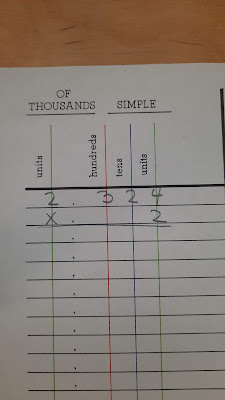*The third of three blog posts about the Montessori Small Bead Frame.
The Small Bead Frame is an arithmetic material which helps a child move toward an abstract understanding of mathematical operations. Addition, subtraction and multiplication equations are solved using this material.
 |
| The Small Bead Frame |
The Small Bead Frame is introduced at either the end of the Montessori casa program (ages 3 to 6 years) or at the beginning of the Montessori lower elementary program (ages 6 to 9 years). Work with the Golden Beads Decimal System material
 |
| The Golden Bead Decimal Material |
and the Stamp Game precedes this work.
 |
| Solving an Addition Equation with the Stamp Game |
How is the Small Bead Frame used to solve multiplication equations?
Before I get to how this material is used for multiplication, it is important to discuss the language used. It differs slightly from more traditional methods. The language is the key. Instead of saying multiplication is two times four, we would say that multiplication is a number taken many times. In this way, we would say two taken four times.
Multiplication - Static
Let's solve a static (no exchanging) multiplication equation.
2,324
x 2
Begin by sliding the quantities of the multiplicand by the multiplier. Slide four unit beads to the right one time and then two times. How many units do we have in total? Write 8 on the Small Bead Frame paper.
 |
| Sliding four beads to the right once and then twice. |
 |
| Four taken two times equals eight. |
Do the same for the tens, hundreds and thousands.
 |
| The product of the equation - 4,648 - is on the right. |
The product is 4,648.
Multiplication ~ Dynamic
Let's solve a dynamic multiplication equation. Dynamic multiplication equations involve exchanging.
2,394
x 2
Begin by sliding the quantities of the multiplicand by the multiplier. Slide 4 unit beads to the right one time and then two times. How many units do we have in total? Write 8 on the Small Bead Frame paper.
Four taken two times equals eight.
Continue with the tens. Slide 9 ten beads to the right one time.
 |
| Nine beads taken one time. |
Slide 9 ten beads to the right a second time. There are not enough beads. Slide the final bead over. That makes 10 beads. 10 ten beads make one hundred.
 |
| Ten ten beads make one hundred. |
Exchange the 10 ten beads by sliding 1 hundred bead to the right. Slide all 10 ten beads to the left.
 |
| Exchange the ten ten beads for one hundred. Slide one red hundred bead to the right. Slide the ten ten beads to the left. |
Continue sliding the ten beads to the right until you have slid 9 over in total don't forget one was already slid over before exchanging). How many tens do we have in total? Write 8 on the Small Bead Frame paper.
 |
| Nine tens taken two times. |
Continue with the hundreds and thousands. Slide 3 hundred beads over one time and then two times. How many hundreds do we have in total? Write 7 on your Small Bead Frame paper. Slide 2 thousand beads over one time and then two times. How many thousands do we have in total? Write 4 on your Small Bead Frame paper.
 |
| The product is 4,788 (on the right). |
The product is 4,788.
Note: This material is introduced to children at 5 1/2 + in a Montessori program (SK - grade 1). Numbers to the thousands are introduced to children in grade 4 of the Ontario Math Curriculum. Multiplication of the times tables up to 7 is expected by the end of grade 3 of the Ontario Math Curriculum.




Such a beautiful post, thanks for sharing. The Small Bead Frame in Montessori materials facilitates multiplication by allowing children to visualize and manipulate quantities. Beads represent units, tens, hundreds, and thousands, enabling students to perform and understand multiplication operations. By moving beads, they concretely see the process of adding multiples, fostering a deeper grasp of multiplication concepts and enhancing their mathematical foundation through hands-on learning.
ReplyDelete